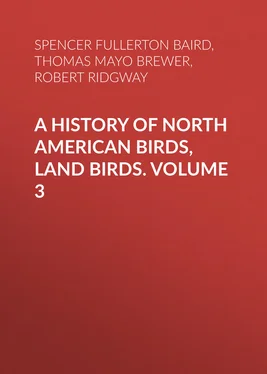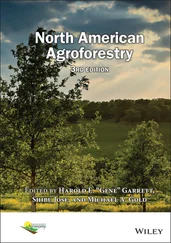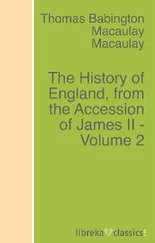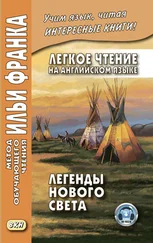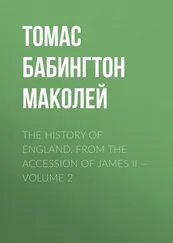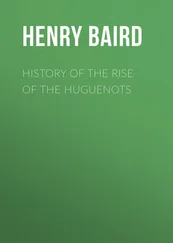Spencer Fullerton Baird - A History of North American Birds, Land Birds. Volume 3
Здесь есть возможность читать онлайн «Spencer Fullerton Baird - A History of North American Birds, Land Birds. Volume 3» — ознакомительный отрывок электронной книги совершенно бесплатно, а после прочтения отрывка купить полную версию. В некоторых случаях можно слушать аудио, скачать через торрент в формате fb2 и присутствует краткое содержание. Жанр: foreign_antique, Биология, foreign_edu, на английском языке. Описание произведения, (предисловие) а так же отзывы посетителей доступны на портале библиотеки ЛибКат.
- Название:A History of North American Birds, Land Birds. Volume 3
- Автор:
- Жанр:
- Год:неизвестен
- ISBN:нет данных
- Рейтинг книги:5 / 5. Голосов: 1
-
Избранное:Добавить в избранное
- Отзывы:
-
Ваша оценка:
- 100
- 1
- 2
- 3
- 4
- 5
A History of North American Birds, Land Birds. Volume 3: краткое содержание, описание и аннотация
Предлагаем к чтению аннотацию, описание, краткое содержание или предисловие (зависит от того, что написал сам автор книги «A History of North American Birds, Land Birds. Volume 3»). Если вы не нашли необходимую информацию о книге — напишите в комментариях, мы постараемся отыскать её.
A History of North American Birds, Land Birds. Volume 3 — читать онлайн ознакомительный отрывок
Ниже представлен текст книги, разбитый по страницам. Система сохранения места последней прочитанной страницы, позволяет с удобством читать онлайн бесплатно книгу «A History of North American Birds, Land Birds. Volume 3», без необходимости каждый раз заново искать на чём Вы остановились. Поставьте закладку, и сможете в любой момент перейти на страницу, на которой закончили чтение.
Интервал:
Закладка:
Falco æsalon , Rich. & Swains. F. B. A. II, pl. xxv, 1831.—Nutt. Man. Orn. II, 558.—Coues, P. A. N. S. Philad. 1866, p. 42 (in text). Falco ( Hypotriorchis ) richardsoni , Ridgway, P. A. N. S. Philad. Dec. 1870, 145. Falco richardsoni , Coues, Key, 1872, p. 214.
Sp. Char. Adult male like the female and young? The known stages of plumage more like the adult female and young of var. lithofalco ( F. æsalon , Auct.) than like var. columbarius .
Adult male (Smithsonian, No. 5,171, mouth of the Vermilion River, near the Missouri, October 25, 1856; Lieutenant Warren, Dr. Hayden). Upper plumage dull earth-brown, each feather grayish-umber centrally, and with a conspicuous black shaft-line. Head above approaching ashy-white anteriorly, the black shaft-streaks being very conspicuous. Secondaries, primary coverts, and primaries margined terminally with dull white; the primary coverts with two transverse series of pale ochraceous spots; outer webs of primaries with spots of the same, corresponding with those on the inner webs. Upper tail-coverts tipped, and spotted beneath the surface, with white. Tail clear drab, much lighter than the primaries, but growing darker terminally, having basally a slightly ashy cast; crossed with six sharply defined, perfectly continuous bands (the last terminal) of ashy-white. Head, frontally, laterally, and beneath,—a collar around the nape (interrupting the brown above),—and the entire lower parts, white, somewhat ochraceous, this most perceptible on the tibiæ; cheeks and ear-coverts with sparse, fine hair-like streaks of black; nuchal collar, jugulum, breast, abdomen, sides, and flanks with a medial linear stripe of clear ochre-brown on each feather; these stripes broadest on the flanks; each stripe with a conspicuously black shaft-streak; tibiæ and lower tail-coverts with fine shaft-streaks of brown, like the broader stripes of the other portions. Chin and throat, only, immaculate. Lining of the wing spotted with ochraceous-white and brown, in about equal amount, the former in spots approaching the shaft. Inner webs of primaries with transverse broad bars of pale ochraceous,—eight on the longest. Wing-formula, 2, 3–4, 1. Wing, 7.70; tail, 5.00; culmen, .50; tarsus, 1.30; middle toe, 1.25; outer, .85; inner, .70; posterior, .50.
Adult female (58,983, Berthoud’s Pass, Rocky Mountains, Colorado Territory; Dr. F. V. Hayden, James Stevenson). Differing in coloration from the male only in the points of detail. Ground-color of the upper parts clear grayish-drab, the feathers with conspicuously black shafts; all the feathers with pairs of rather indistinct rounded ochraceous spots, these most conspicuous on the wings and scapulars. Secondaries crossed with three bands of deeper, more reddish ochraceous. Bands of the tail pure white. In other respects exactly as in the male. Wing-formula, 3, 2–4–1. Wing, 9.00; tail, 6.10; culmen, .55; tarsus, 1.40; middle toe, 1.51.
Young male (40,516, Fort Rice, Dacotah, July 20, 1865; Brig.-Gen. Alfred Sully, U. S. A., S. M. Rothammer). Differing from the adult only in minute details. Upper surface with the rusty borders of the feathers more washed over the general surface; the rusty-ochraceous forms the ground-color of the head,—paler anteriorly, where the black shaft-streaks are very conspicuous; spots on the primary coverts and primaries deep reddish-ochraceous; tail-bands broader than in the adult, and more reddish; the terminal one twice as broad as the rest (.40 of an inch), and almost cream-color in tint. Beneath pale ochraceous, this deepest on the breast and sides; markings as in the adult, but anal region and lower tail-coverts immaculate; the shaft-streaks on the tibiæ, also, scarcely discernible. Wing, 7.00; tail, 4.60.
Hab. Interior regions of North America, between the Mississippi Valley and the Rocky Mountains, from Texas to the Arctic regions.
National Museum, 10; Museum Comp. Zoöl., 2; R. Ridgway, 3. Total, 15.

Since originally describing this bird, I have seen additional examples, and still consider it as an easily recognized race, not at all difficult to distinguish from columbarius . Now, however, I incline strongly to the theory that it represents merely the light form of the central prairie regions, of the common species; since its characters seem to be so analogous to those of the races of Buteo borealis and Bubo virginianus of the same country. It is doubtful whether some very light-colored adult males, supposed to belong to columbarius , as restricted, should not in reality be referred to this race, as the adult plumage of the male. But having seen no adult males from the region inhabited by the present bird obtained in the breeding-season, I am still in doubt whether the present form ever assumes the blue plumage.
As regards the climatic or regional modifications experienced by the Falco lithofalco on the American continent, the following summary of facts expresses my present views upon the subject. First: examples identical in all respects, or at least presenting no variations beyond those of an individual character, may be found from very widely separated localities; but the theory of explanation is, that individuals of one race may become scattered during their migrations, or wander off from their breeding-places. Second: the Atlantic region, the region of the plains, and the region of the northwest coast, have each a peculiar race, characterized by features which are also distinctive of races of other birds of the same region, namely, very dark—the dark tints intensified, and their area extended—in the northwest coast region; very light—the light markings extended and multiplied—in the middle region; and intermediate in the Atlantic region.
Habits. The distribution of the well-known Pigeon Hawk is very nearly coextensive with the whole of North America. It is found in the breeding-season as far to the north as Fort Anderson, on the Anderson and McKenzie rivers, ranging even to the Arctic coast. Specimens were taken by Mr. Ross at Lapierre House and at Fort Good Hope. Several specimens were taken by Mr. Dall at Nulato, where, he states, it is found all the year round. They were also taken by Bischoff at Kodiak. During the breeding-season it is found as far south as Nova Scotia, New Brunswick, and the northern portions of Maine, and probably Vermont and New York. It is abundant on the Pacific coast.
Конец ознакомительного фрагмента.
Текст предоставлен ООО «ЛитРес».
Прочитайте эту книгу целиком, купив полную легальную версию на ЛитРес.
Безопасно оплатить книгу можно банковской картой Visa, MasterCard, Maestro, со счета мобильного телефона, с платежного терминала, в салоне МТС или Связной, через PayPal, WebMoney, Яндекс.Деньги, QIWI Кошелек, бонусными картами или другим удобным Вам способом.
1
The whole of the systematic portion of the article on the Raptores , has been prepared by Mr. Ridgway; the biographies, however, are furnished by Dr. Brewer, as usual. The outlines of the skulls and sterna of the Strigidæ , the skulls, sterna, and heads of the Cathartidæ , and the generic outlines of the Falconidæ and Cathartidæ , were drawn by Mr. Ridgway.—S. F. Baird.
Читать дальшеИнтервал:
Закладка:
Похожие книги на «A History of North American Birds, Land Birds. Volume 3»
Представляем Вашему вниманию похожие книги на «A History of North American Birds, Land Birds. Volume 3» списком для выбора. Мы отобрали схожую по названию и смыслу литературу в надежде предоставить читателям больше вариантов отыскать новые, интересные, ещё непрочитанные произведения.
Обсуждение, отзывы о книге «A History of North American Birds, Land Birds. Volume 3» и просто собственные мнения читателей. Оставьте ваши комментарии, напишите, что Вы думаете о произведении, его смысле или главных героях. Укажите что конкретно понравилось, а что нет, и почему Вы так считаете.
